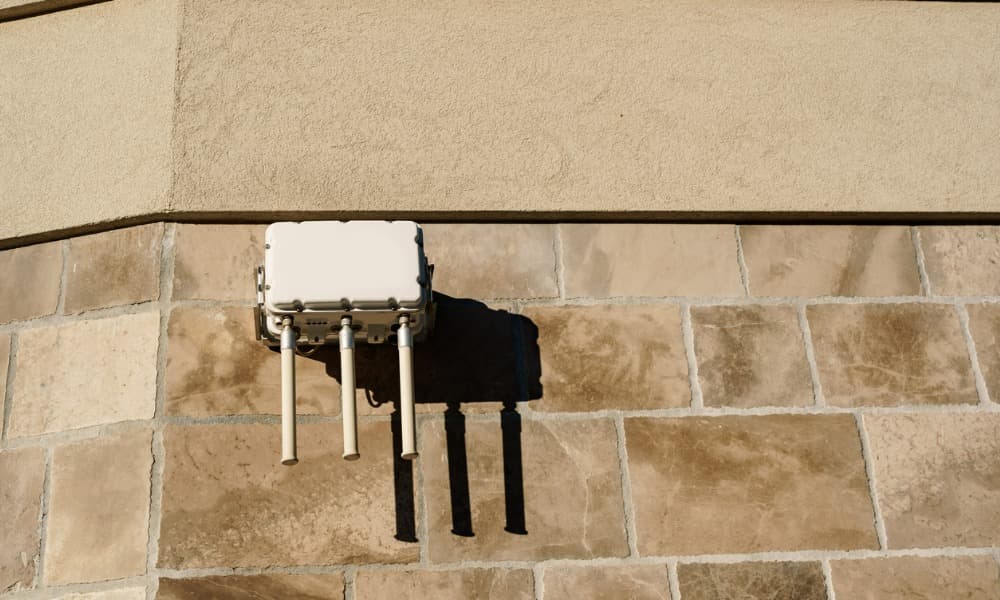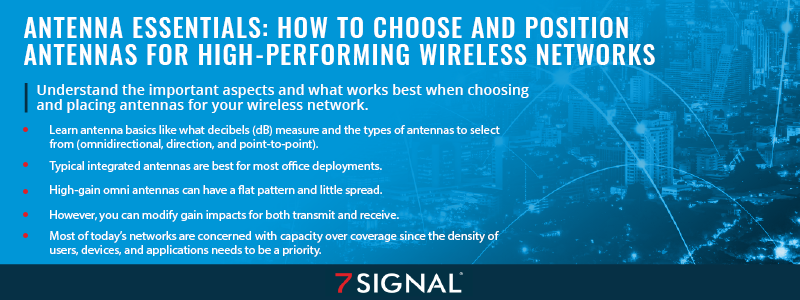
Blog
Antenna Essentials: How to Choose and Position Antennas for High-Performing Wireless Networks
Understand the important aspects and what works best when choosing and placing antennas for your wireless network.

A seven-year veteran with 7SIGNAL, senior systems engineer Mike Graham has been designing, installing, and troubleshooting wireless LANs since 1994. In the webinar, Antenna Selection and Positioning, Mike discussed key points from 7SIGNAL’s revised Antenna Selection and Positioning Guide.
Antenna basics
The guide is not deeply technical but offers valuable information about antennas, their uses, and how to select the right one for various applications. It begins by defining and discussing essential terms related to antennas.
One key term to note sis decibels (dB). These are a crucial concept in radio frequency (RF) and represent a logarithmic scale that helps quantify a wide range of power levels. This scale can efficiently represent power differences from barely perceptible sound to extremely loud noise.
The guide delves into the various classifications of antennas, including:
- Omni-directional antennas
- Directional antenna
- Point-to-point (or highly directional) antennas
Each type of antenna has specific uses and applications. For instance, internal antennas in access points are often small and have a semi-hemispherical or “blob” pattern, making them suitable for indoor spaces. The guide also discusses when to use high gain antennas, directional antennas, and highly directional antennas, providing valuable information for antenna selection.
Typical integrated antennas are going to be the best option for most office deployments, where access points (APs) and client devices are pretty close to each other. This is because the main priority is not coverage but capacity (more on that later).
Integrated antennas are not as suitable for large open spaces, like warehouses and distribution centers with relatively low user densities, low bandwidth application requirements, and very high ceilings.
You can increase the capacity for today’s networks by deploying more APs with smaller coverage cells. They’re servicing fewer clients per AP.
One additional note: Yagis, a type of point-to-point antenna, is not common anymore. The manufacturing cost is so much higher than a patch or panel type of antenna, and yet the performance is similar. Antennas that are easier to use have largely replaced them.
External antenna considerations
There are a few key considerations for external antenna placement. First is going too far with high-gain antennas. High-gain omnis have a very flat pattern and not a lot of spread in a vertical direction. If they’re placed high up, sometimes your users end up under the coverage pattern.
Another thing to consider is how you choose external antennas for each band. Be aware of dual-band and single-band antennas, besides 5 GHz versus 2.4 GHz versus both. Watch for the upcoming tri-band antennas, too, which include 6 GHz.
Next is minimizing cable length and connectors. Cables are pretty hard to deal with. They impact RF energy, and good cables are expensive. If you find a deal on a cable that should be expensive, it’s probably a counterfeit.
Increasing antenna gain improves both transmit and receive. This is because the law of reciprocity applies. Tx and Rx gain are the same, so there’s tension.
For example, switching from an integrated 3 dBi antenna to an external antenna with 9 dBi, which is a jump of 6 dB, would quadruple the power resulting in double the cell radius in an open space. Also, unlike increasing transmit power alone, it is less likely to result in an asymmetric data rate between clients and APs.
Many people think of the antenna on only the transmit side, but whatever it does on one side, it does on the other, which is usually a good thing. You’re increasing receive signal strength so users will get better data rates on the uplink side. However, this also means the AP will hear noise better and may pick up a distant noise. If you can pinpoint the noise source, you can use a null point to “null” out the noise points.
Capacity versus coverage
As enterprises become increasingly dependent on Wi-Fi, those with high user densities constantly demand more performance. Cranking up transmit power is not the answer, nor is switching to high-gain antennas.
Most networks are designed with capacity as the goal. Only considering coverage is not very common today. Putting a higher-gain antenna on an AP increases the reach of its transmissions, but it also increases the gain on the receiving side. It has an equal effect on transmit and receive, unlike turning up the transmit power of an AP, which only affects the transmit distance.
It’s important to understand user density and performance requirements. An antenna is cheaper than an AP, and if there’s a large open area with few users, there’s no problem with running more gain and getting more coverage with an AP. But doubling or quadrupling the coverage doesn’t increase the performance in that cell. There’s that capacity versus coverage tension.
Placement and monitoring best practices
In the real world, you can’t always use access points because of mounting, lack of cabling, on-site computers, or inefficient knowledge of the surroundings (walls, furniture, etc.). A placement selection may be ideal for some things but not others, and you make tradeoffs and accept compromises.
Interference can cause issues, including with the Wi-Fi provider. Thus, some placement compromises are costlier to performance than others. Consider important antenna placement factors like the following:
- Aesthetics over function
- Placement above a suspended ceiling
- 2.4 GHz planning
- 2G, 3G, 4G, and 5G planning
- Metallic paint
- Beamforming
- Typical ceiling mounting
- EM interference
- Oversized cells
- Microwave ovens
- Outdoor APs
- Dealing with high ceilings
- Metal objects
- Auto RF tuning
- Paddle antenna angles
- MIMO
For example, EM interference. Motors can actually cause interference, as can industrial heaters and computers. Some of these can radiate RF. You never know where interference is going to come from.
Therefore, monitor and plan to conduct routine site surveys to be aware of changes, which can be rapid. Site surveys are simply brief snapshots of the RF environment on your premises. The fact is, the RF environment inside and outside your building is never static. In years past, 802.11abg replaced 802.11n, then 802.11ac replaced 802.11n, and now 802.11ax is replacing 802.11ac.
Carefully design your Wi-Fi network at the outset. You want to have a plan to regularly check to make sure the network is meeting the requirements it had before, and often those do change. New clients and applications show up, and the RF environment changes. More frequent changes occur, like RRM, hotspots coming and going, and sources of Wi-Fi and non-Wi-Fi interference arising.
You need to understand user densities and whether you’re going to need dense deployment of APs there when doing site surveys. You also must know whether it’s a place where you just need good coverage and won’t get much use. Then, you can try to stretch out the AP’s coverage.
Learn more about wireless network monitoring from 7SIGNAL
The team at 7SIGNAL deploys our wireless experiencing monitoring platform to help you monitor and improve your wireless network at all times. Learn more by contacting 7SIGNAL today.
7SIGNAL® is the leader in wireless experience monitoring, providing insight into wireless networks and control over Wi-Fi performance so businesses and organizations can thrive. Our cloud-based wireless network monitoring platform continually tests and measures Wi-Fi performance at the edges of the network, enabling fast solutions to digital experience issues and stronger connections for mission-critical users, devices, and applications. Learn more at www.7signal.com.